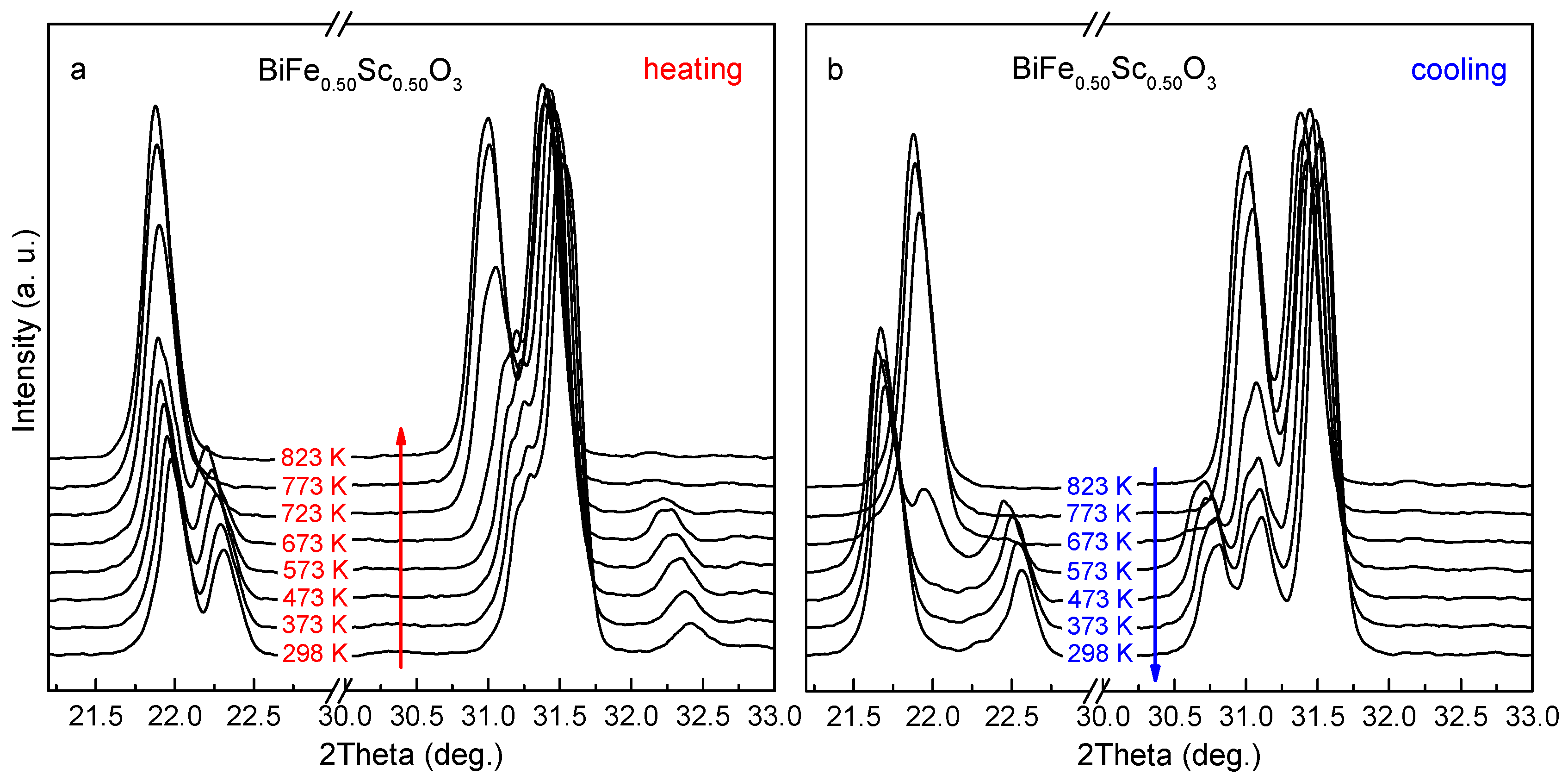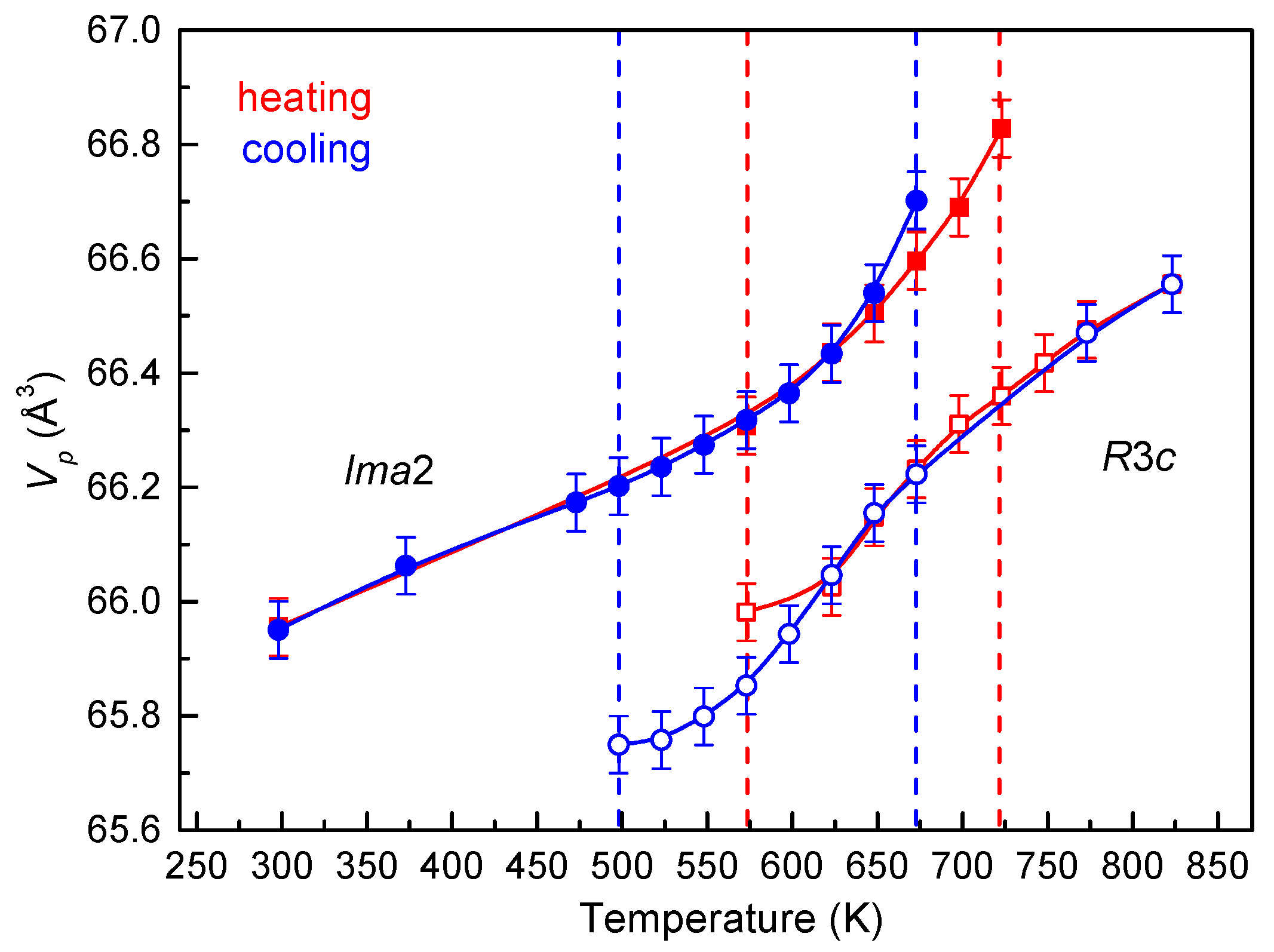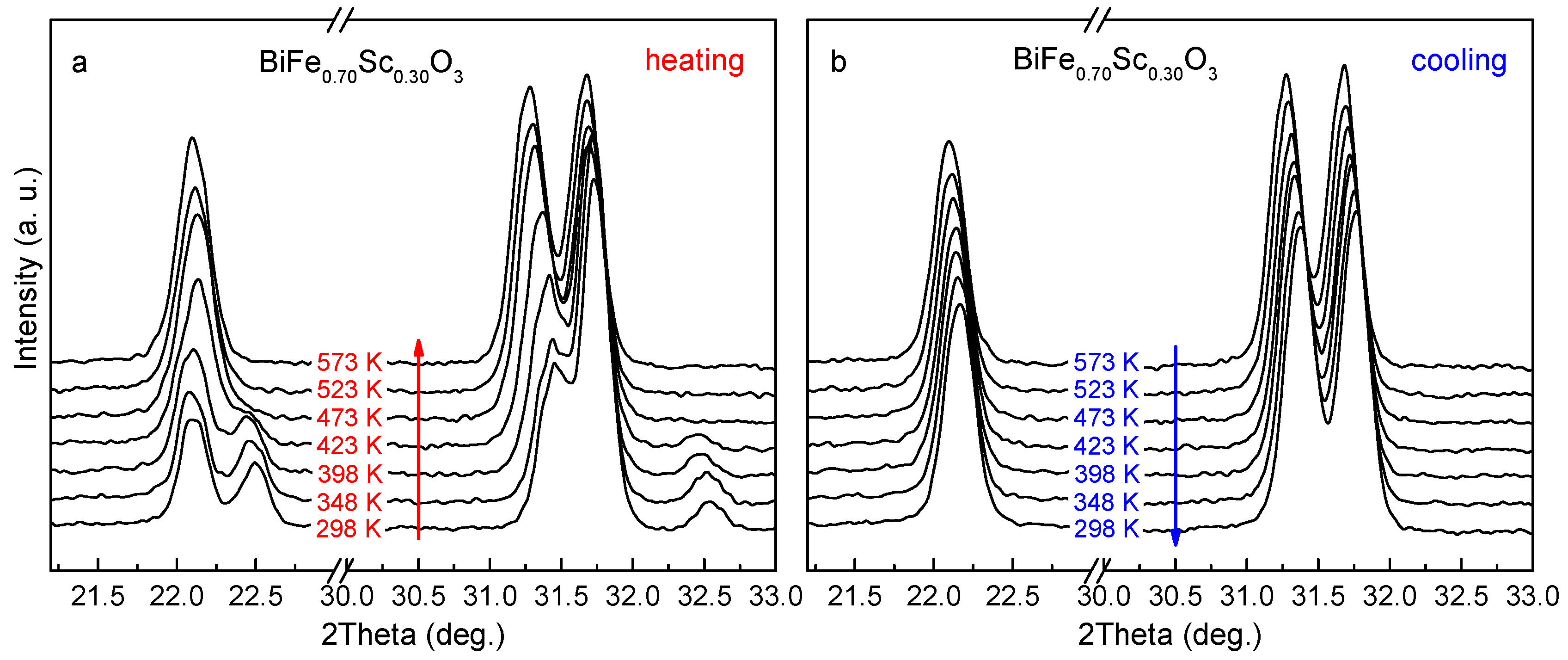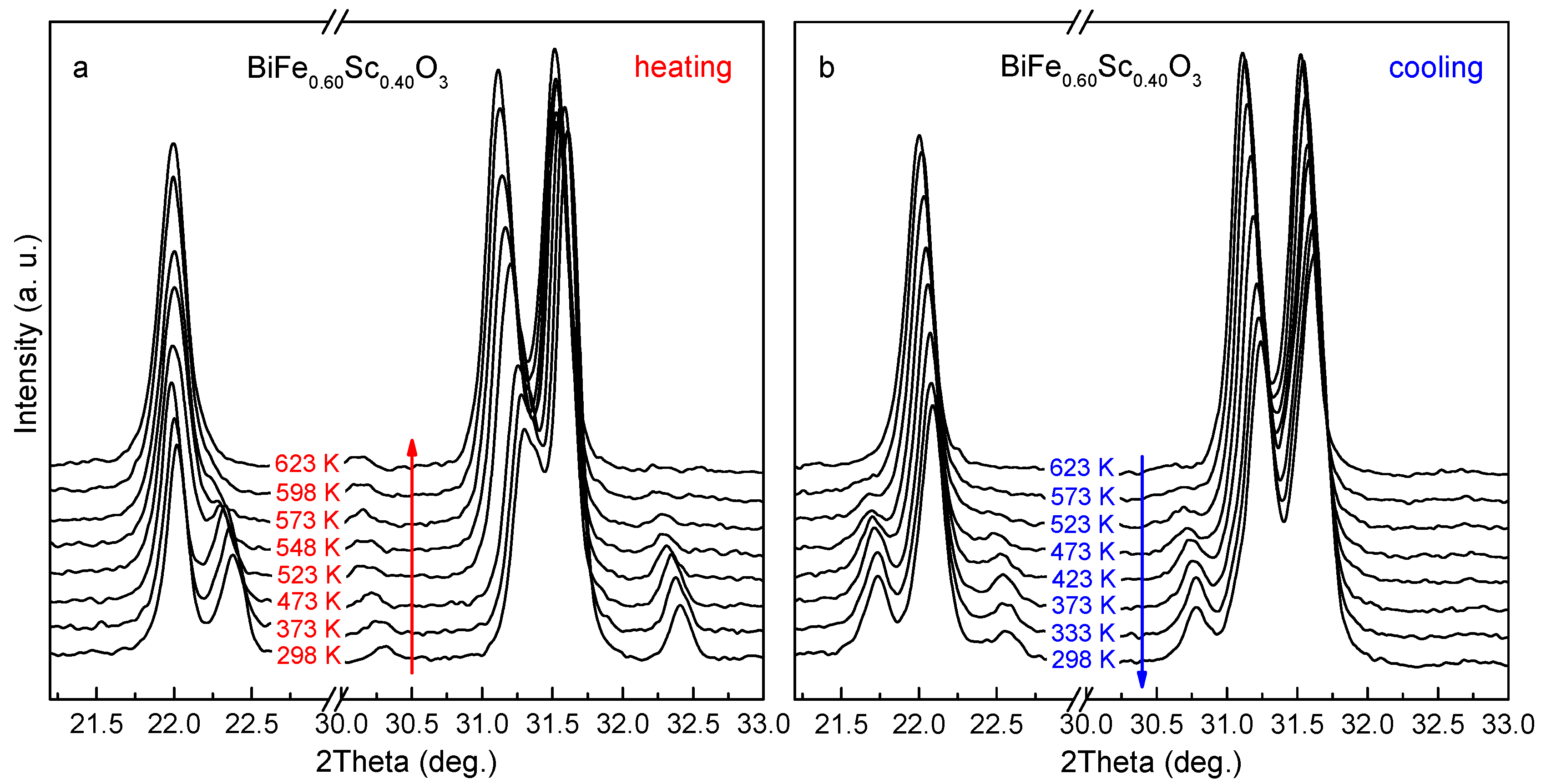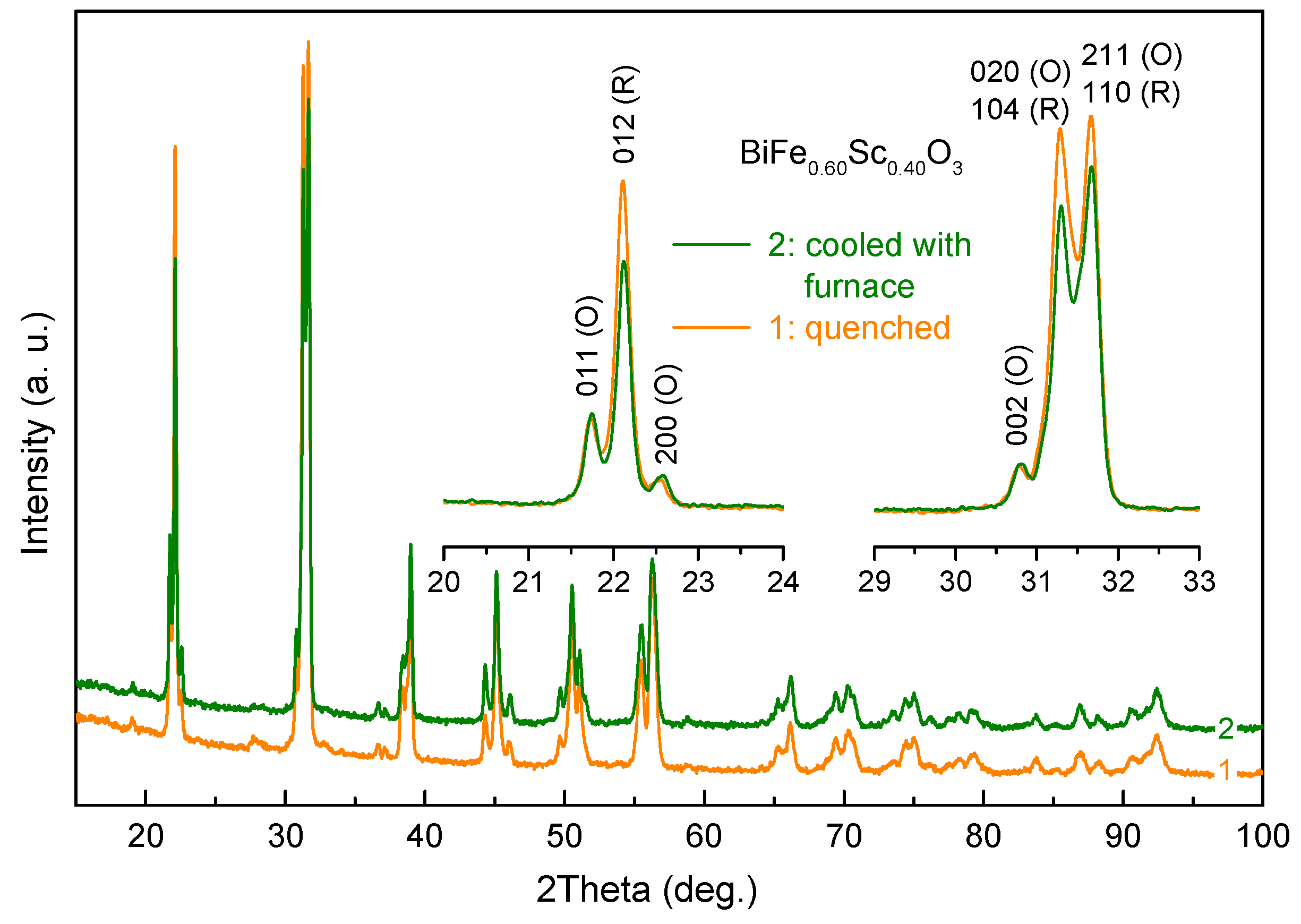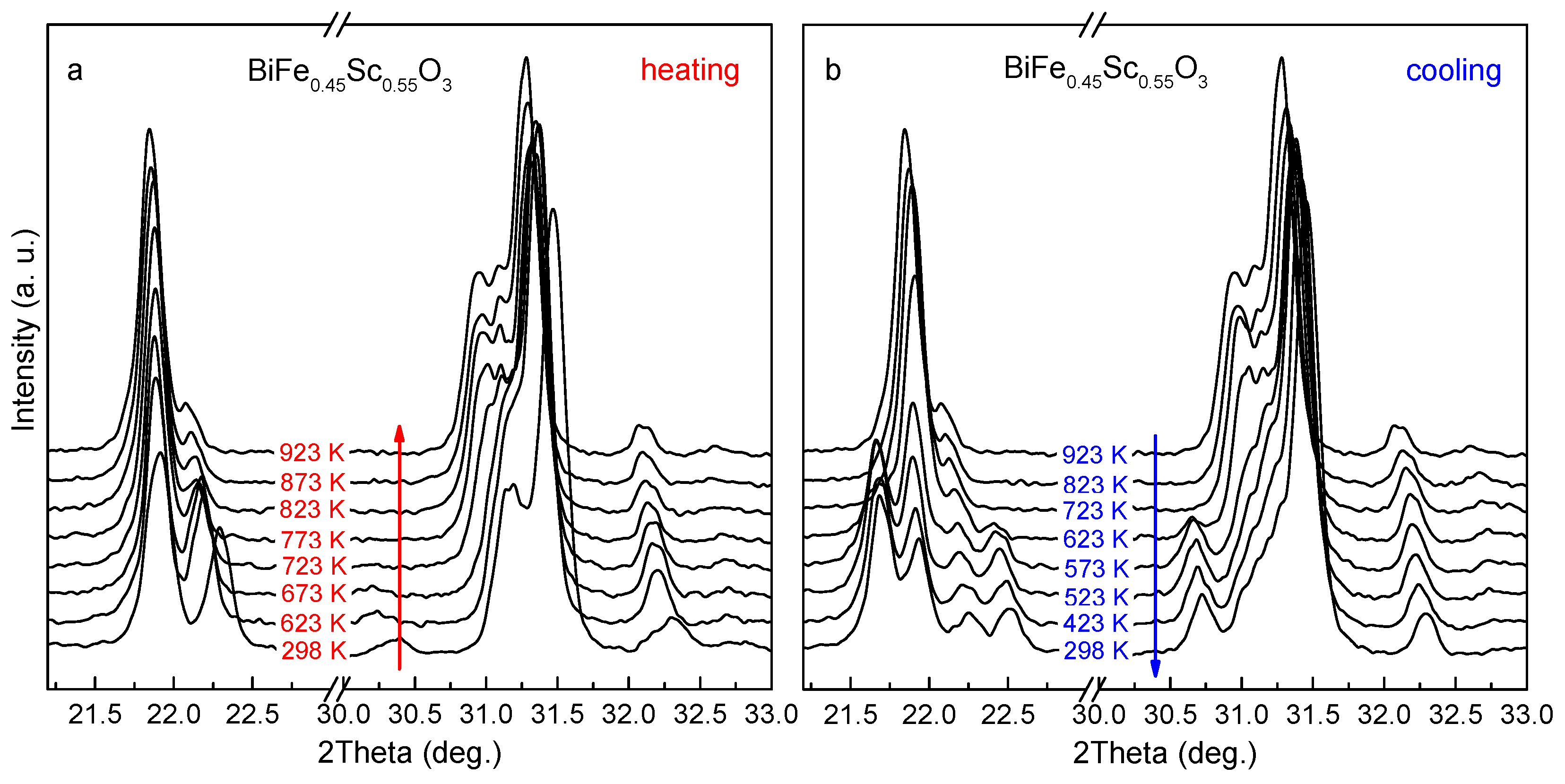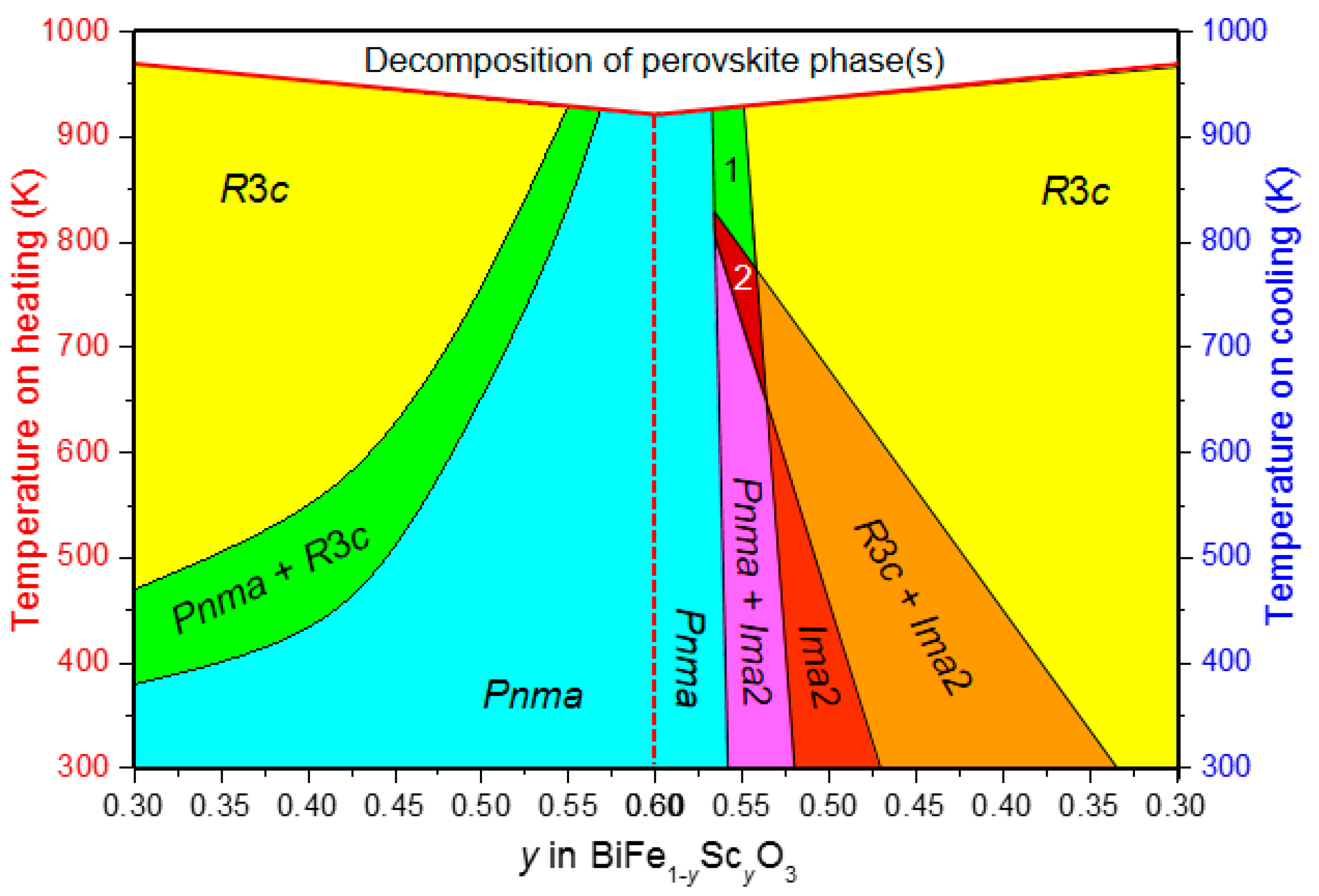1. Introduction
Perovskite multiferroics based on chemically modified bismuth ferrite attract great attention in respect to both fundamental research and practical application [
1,
2]. While the conventional preparation methods are generally applicable to obtain bulk polycrystalline samples with the entire range of the Bi-site substitutions, a wide range of Fe-site substitutions are possible under high pressure only. The high-pressure synthesis technique offers unique opportunities to obtain new phases but requires complicated and expensive equipment. Besides, a sample obtained as a result of one high-pressure high-temperature run, is rather small. In cases when the required pressure is above ~8 GPa, the obtained amounts are hardly enough, even for the crystal structure characterization. The cases when researchers managed to measure dielectric properties of the high-pressure synthesized ceramics are rather rare [
3,
4,
5,
6,
7].
The metastable perovskites with the 1:1 ratio of Fe
3+ to the substituting
B3+ cation are the most studied [
8,
9,
10,
11]. Generally speaking, the compositional ranges of interest where new phases or phases with adjusted properties occur are usually beyond the BiFe
0.50B3+0.50O
3 formula. However, there are only a few entire series of BiFeO
3–Bi
B3+O
3 solid solutions have been prepared under high pressure [
12,
13,
14].
Among the structural phases found in the BiFeO
3-based perovskite solid solutions, one of the most interesting phases appears to be the antipolar orthorhombic
Pnma with the
superstructure (where
ap ~4 Å is the pseudocubic perovskite unit-cell parameter). The antipolar
Pnma phase is observed in the perovskite solid solutions prepared using conventional methods ((Bi,La)FeO
3 [
15], (Bi,Nd)FeO
3 [
16,
17]), and the high pressure synthesis (Bi(Fe
,Mn)O
3 [
12,
18]). The characteristic feature of this antipolar structure is a rather interesting rotational (tilting) octahedra pattern of the ++−− type, where “+” and “−” indicate in-phase and out-of-phase rotations of the oxygen octahedra about the [010]
p axis, respectively.
The most complete series of the (1−
y)BiFeO
3-
yBiScO
3 solid solutions has recently been synthesized under high-pressure [
19]. The compositional range of the metastable antipolar
Pnma phase is rather wide, namely between about
y = 0.30 and
y = 0.60. The thermal stability limits of these compositions were estimated to be in the range of 920–870 K when 0.30 ≤
y ≤ 0.60, respectively. The stability limit is defined as a temperature that is 50 K lower than that of the irreversible decomposition accompanied by the formation of non-perovskite phase(s).
To date, the most studied composition of the BiFe
1−ySc
yO
3 series is that, corresponding to
y = 0.50 [
11]. It was revealed that two nonequivalent structures with the same
Pnma space group are possible for BiFe
0.50Sc
0.50O
3 [
11,
20]. In addition, an annealing-stimulated polymorphic transformation has been found. The antipolar
Pnma phase in the as-prepared (non-annealed) BiFe
0.50Sc
0.50O
3 sample was observed to transform irreversibly into the polar
R3
c phase when heated. The latter then transforms reversibly into the polar
Ima2 phase when cooled. The
Ima2 polymorph of BiFe
0.50Sc
0.50O
3 demonstrates the complex polar structure and represents one of the rare examples of canted ferroelectrics [
11]. It is a great advantage that two different perovskite polymorphs of the same composition are available for any comparative study in the same wide temperature range, which includes room temperature.
For the BiFe0.50Sc0.50O3 composition, the competing phases are those with the antipolar Pnma, the polar R3c, and the polar Ima2 structures. As a part of the systematic study of perovskite phases of the BiFe1−yScyO3, the relations between these (and probably other) phases in compositions from a wider range of the iron-to-scandium substitutions, namely in the range of 0.30 ≤ y ≤ 0.60, were considered.
In this paper, we report on the temperature behaviour of the metastable perovskite phases of the BiFe1−yScyO3 series studied using in situ powder X-ray and neutron diffraction. The revealed phase transformations were compared with those observed in other metastable solid solutions derived from BiFeO3.
2. Materials and Methods
High-purity Bi2O3, Fe2O3, and Sc2O3 were used as starting reagents to prepare the following compositions of the BiFe1−yScyO3 series: y = 0.30, 0.40, 0.45, 0.50, 0.55, and 0.60. The oxides were mixed in the stoichiometric ratio, ball-milled in ethanol, dried, and pressed into pellets. The pellets were heated in a closed alumina crucible at 1040 K for 10 min followed by quenching in air. The obtained material served as a precursor for the high pressure synthesis.
High pressure was generated using a hydraulic anvil press DO-138A (with a press capacity of 6300 kN) equipped with a Bridgman-type apparatus (Tyazhpressmash, Ryazan, Russia). The samples were synthesized at 6 GPa and 1370–1470 K for 1–2 min. In order to avoid the penetration of graphite from the tubular heater to the sample, a protective screen of molybdenum foil was used. For further analyses, the obtained ceramics were reduced to powders.
An X-ray diffraction (XRD) study of the powders was performed using a PANalytical X’Pert MPD PRO diffractometer (Ni-filtered Cu Ka radiation, PIXcel1D detector, and an exposition corresponding to about 2 s per step of 0.02° over the angular range of 15–100°, Almelo, Netherlands) at room temperature. In situ XRD measurements were conducted in an Anton Paar high-temperature chamber (HTK 16N) in a temperature range between 300 and 920 K. A dwell time before the XRD data collecting at each temperature point was 30 min.
Neutron powder diffraction data were collected at the ISIS pulsed neutron and muon facility of the Rutherford Appleton Laboratory (UK) on the WISH diffractometer located at the second target station [
21]. The sample was loaded into a cylindrical 3-mm-diameter vanadium can and measured in a temperature range of 1.5–300 K, with the exposition time of 0.5 h using an Oxford Instruments cryostat (Abington, UK).
Rietveld refinements of the crystal (from both X-ray and neutron diffraction data) and magnetic structures (from neutron diffraction data) were performed using the FULLPROF program [
22]. In the refinement procedure, the nominal cation compositions were fixed with Bi and Sc/Fe located in the
A- and
B-site perovskite positions, respectively. Some trial refinements with unfixed cation occupancies were also performed to explore possible deviations from the nominal chemical compositions. No statistically significant deviations were revealed, confirming the nominal chemical content and the cation distribution in the studied samples.
3. Results and Discussion
As mentioned in the introduction, the heating/cooling thermal cycle of the as-prepared BiFe
0.50Sc
0.50O
3 results in transformation from the antipolar orthorhombic polymorph to the polar orthorhombic phase via formation of the intermediate high-temperature rhombohedral phase [
11].
Figure 1 shows the most representative ranges of the temperature XRD patterns of BiFe
0.50Sc
0.50O
3. Upon heating, the antipolar orthorhombic
Pnma phase of BiFe
0.50Sc
0.50O
3 is the only phase up to about 720 K. This orthorhombic phase coexists with the rhombohedral
R3
c phase until about 770 K. At higher temperatures, only the rhombohedral phase is observed (
Figure 1a). Upon cooling, the polar orthorhombic phase appears at about 670 K. Below 570 K, the
R3
c-to-
Ima2 transformation is complete (
Figure 1b).
It should be pointed out that the polar atomic displacements in both the rhombohedral and orthorhombic phases are sufficiently large, even at high temperatures to be reliably detected from the available XRD patterns. Refinements of the data using the centrosymmetric counterparts
and
Imma resulted in an unacceptable fitting quality and could be safely ruled out. Irreversible annealing-stimulated transformations
Pnma-to-
R3
c and
C2/
c-to-
Pnma were previously observed in the metastable perovskites BiFe
0.75Mn
0.25O
3 [
18] and BiGa
1−xCr
xO
3 (0.70 ≤
x ≤ 0.90) [
14], respectively. In these systems, however, the transformations are direct without formation of any intermediate high-temperature phase(s).
The second and all of the following heating/cooling thermal cycles, with maximum temperature not exceeding 920 K, demonstrated that the transition between the
Ima2 phase and the
R3
c phase in BiFe
0.50Sc
0.50O
3 is reversible. The
R3
c phase appears at about 570 K and disappears at 500 K, while the orthorhombic
Ima2 phase disappears at about 720 K and appears again at about 670 K (
Figure 2).
In the XRD patterns of the in situ studied BiFe
0.70Sc
0.30O
3 ceramics, regular changes in both the shape and the intensity ratio of the fundamental reflections, suggesting an onset of an
R3c phase, were observed to appear between 380 K and 400 K (
Figure 3a). The transformation was complete at about 470 K: no traces of the parent
Pnma phase were observed above this temperature. The transformation was irreversible since the rhombohedral symmetry of the annealed BiFe
0.70Sc
0.30O
3 sample remains when the sample is cooled down to room temperature (
Figure 3b).
Although the annealing-stimulated transition from the antipolar
Pnma phase to the polar
R3
c phase observed in BiFe
0.70Sc
0.30O
3 is very similar to that reported for the high-pressure prepared BiFe
0.75Mn
0.25O
3 [
18], it should be noted that the
R3
c phase of BiFe
0.75Mn
0.25O
3 is stable (i.e., it can be prepared via conventional synthesis at ambient pressure), while both the
Pnma and the
R3
c phases of BiFe
0.70Sc
0.30O
3 are metastable [
19].
In the as-prepared BiFe0.70Sc0.30O3 and BiFe0.50Sc0.50O3, the annealing-stimulated transformations are complete. The annealed samples are single-phase—the rhombohedral R3c and the orthorhombic Ima2, respectively.
As can be seen in
Figure 4a, in the sample with the intermediate composition (with the relative scandium content
y = 0.40), the sequence of phase transformations and phase coexistence is qualitatively the same as that in the samples, with compositions corresponding to
y = 0.30 and
y = 0.50. An increase in temperature leads to the formation of the rhombohedral
R3
c phase that coexists with the parent orthorhombic
Pnma phase in some temperature range. Above about 550 K, the rhombohedral phase is only observed. However, the
R3
c-to-
Ima2 transformation on cooling is incomplete: the annealed sample at room temperature was found to be a mixture of the rhombohedral and the orthorhombic phases (
Figure 4b). The consecutive thermal cycles with the maximum temperature not exceeding the thermal stability limit of the perovskite BiFe
0.60Sc
0.40O
3 [
19] resulted in no change in the ratio of the
R3
c and
Ima2 phases in the annealed sample at room temperature.
In the BiFe
0.55Sc
0.45O
3 composition, the transformations from the parent orthorhombic phase into the rhombohedral phase upon heating and from the rhombohedral phase into the polar orthorhombic phase upon cooling both begin at higher temperatures than those of the respective transformations in BiFe
0.60Sc
0.40O
3; however, the temperature behaviours of these compositions with
y = 0.45 and
y = 0.40 are the same in general. At room temperature, the annealed BiFe
0.55Sc
0.45O
3 samples represented a mixture of the
R3
c and
Ima2 phases as well. The relative stabilities of these phases were particularly studied. The two-phase perovskite samples were obtained by means of either quenching or slow cooling from the temperature range where the only structural phase is the rhombohedral phase.
Figure 5 demonstrates the XRD patterns of the quenched and the slow-cooled BiFe
0.60Sc
0.40O
3 samples. It can be seen that the relative amount of the
Ima2 phase in the slow-cooled sample is slightly higher than that in the quenched sample, although the difference is rather negligible.
In the studied BiFe1−yScyO3 perovskites with the compositions corresponding to y = 0.40 and y = 0.45, a transformation of the rhombohedral phase into the polar orthorhombic phase upon cooling starts at a relatively low temperature and slows down fast as temperature decreases. Therefore, the observed phase ratio in the annealed sample at room temperature is almost independent on the cooling rate.
The behaviour of the
R3
c +
Ima2 mixture in the annealed BiFe
0.60Sc
0.40O
3 samples below room temperature was also studied using neutron diffraction. It was found that both the
R3
c and
Ima2 phases and their ratio remain without any change down to 1.5 K. The as-prepared BiFe
0.60Sc
0.40O
3 and BiFe
0.50Sc
0.50O
3 were studied as well at the same conditions. No transformation of the antipolar orthorhombic phase was observed. Thus, both the as-prepared perovskite phase and that obtained as a result of the heating/cooling thermal cycling are stable upon cooling to below room temperature. The refinement of the neutron diffraction data required also the inclusion of the long-range
G-type of antiferromagnetic ordering in all three phases with the
R3c,
Ima2 and
Pnma space groups. The magnetic structure of the single phase as-prepared BiFe
0.60Sc
0.40O
3 was found to be identical to the spin ordering reported in the isostructural BiFe
0.50Sc
0.50O
3 perovskite (the spins are along the
b-axis) [
11]. Crystallographic directions of the spins in the phase-mixed annealed BiFe
0.60Sc
0.40O
3 sample, however, could not be concluded unambiguously from the available diffraction data.
It was found that the transition from the parent
Pnma phase of the BiFe
0.45Sc
0.55O
3 composition to the rhombohedral
R3
c phase upon heating begins at a relatively high temperature and is not completed at the decomposition temperature of the perovskite phases (
Figure 6a). The
Pnma phase that was not transformed upon heating was observed to remain untransformed when cooled, while the high-temperature
R3
c phase entirely transformed into the
Ima2 phase between about 670 and 600 K (
Figure 6b). Attempts to complete the
Pnma-to-
R3
c transformation in the following thermal cycles were unsuccessful.
In the case of the BiFe0.40Sc0.60O3 composition, no sign of phase transition was observed upon either heating or cooling. The parent Pnma phase was the only structural phase observed until the decomposition temperature was reached.
Based on the data of the in situ temperature XRD study, a tentative state diagram of the BiFe
1−ySc
yO
3 series in the range of 0.30 ≤
y ≤ 0.60, where the as-prepared phase is the antipolar orthorhombic phase, was suggested (
Figure 7). The right part of the diagram indicates the irreversible
Pnma-to-
R3
c transitions (both complete and incomplete), while the transitions shown in the left part are all reversible.
We would like to stress that all the perovskite phases studied in this work are metastable and decompose when annealing above their temperature stability limits, which are in the range of 920–870 K when y is between 0.30 and 0.60, respectively [
19]. However, this range is well above the operating ranges of the majority of electronic devices. Therefore, materials based on the metastable perovskite phases of the BiFe
1−ySc
yO
3 series have a potential for application. A remarkable feature of this perovskite system is that the pattern of the state diagram is dependent on the maximum temperature in the first thermal cycle. By means of controlled annealing, materials with different combinations of the perovskite phases can be obtained. This feature of metastable perovskites could be used, e.g., for the creation of new materials with a morphotropic phase boundary.
It should be noted that the antipolar orthorhombic
Pnma phase and the polar rhombohedral
R3
c phase are always observed in BiFeO
3-derived solid solutions, while the metastable polar orthorhombic
Ima2 phase was found in the BiFe
1−ySc
yO
3 system only. In other single-phase perovskite solid solutions prepared so far, using a high-pressure synthesis, iron was substituted either by the cations of transition metals (Mn
3+ [
10,
12,
18], Co
3+ [
13,
23], Cr
3+ [
9]) with an ionic size similar to that of Fe
3+ or by Ga
3+ [
14], whose size is 8% smaller. The peculiarity of the BiFe
1−ySc
yO
3 perovskite series is that the ionic size of Sc
3+ is 24% greater than that of Fe
3+. One can suppose that the onset of the
Ima2 phase, which has a reduced unit-cell volume that is greater than those of the
Pnma and
R3
c phases in a particular BiFe
1−ySc
yO
3 composition at the same temperature, is associated with the geometrical factor (negative chemical pressure). Hence, one can suggest that new polar phases such as the
Ima2 phase can be induced in other BiFeO
3-derived metastable solid solutions, in which Fe
3+ is substituted by
B3+ cations or by combinations of cations, such as (
B2+1/2B4+1/2), whose (average) cation size is bigger than that of iron. Such solid solutions certainly require a high-pressure synthesis. The temperature stability limit of the metastable phases can be expected to correlate with the substitution rate: a greater substituting cation induces a faster compositional decrease in the stability limit. Therefore, the chances of obtaining a new phase via annealing-stimulated irreversible transformation will decrease as the substitution rate increases.
